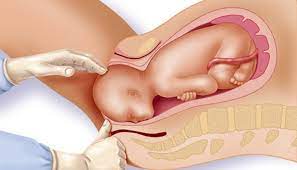Definition
Labour can be diagnosed when there are painful contractions at intervals of less than ten minutes with effacement and dilation of the cervix.
Etiology- At 36/40, oxytocin receptors in the myometrium begin to increase in number
- Uterus begins to respond to pulsatile oxytocin release from the posterior pituitary
- Contractions push the presenting part against the cervix
- This stimulates further oxytocin release in a positive feedback loop (the Ferguson Reflex)

First stage – cervical opening
- Latent first stage
- Irregular contractions
- Some effacement
- Dilation 0-5cm
- Active first stage
- Four contractions every ten minutes
- Substantial effacement
- Dilation 5-10cm (up to full dilation)
Second stage – dilation to delivery
- Passive second stage
- From full dilation until presenting part reaches the pelvic floor
- Should not exceed two hours
- Active second stage
- Pressure on the pelvic floor causes urge to push
- Should not exceed one hour
Third stage – delivery of the placenta
- Active management of the third stage is standard in Australian hospitals
This mechanism only applies if the baby is in vertex presentation.
- Flexion
- Head should be flexed in the uterus
- Baby descends and meets the pelvic floor
- Internal rotation
- Head rotates 90o (normally to occipitoanterior position)
- Body turns 45 o to a transverse position
- Baby descends to the pubic arch
- Extension
- Head extends to travel under the pubic arch
- Head is delivered
- Restitution
- Head rotates back 45 o to align with the body
- External rotation
- Body rotates to anteroposterior alignment for birth
- Body is delivered
